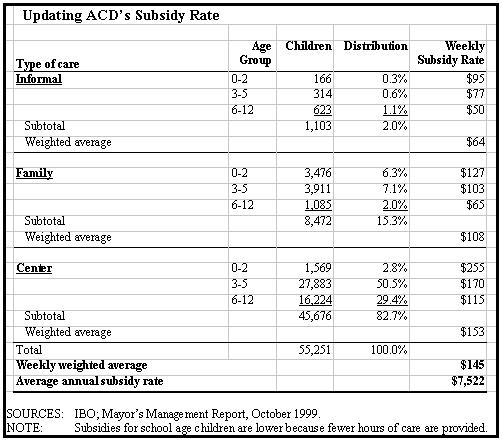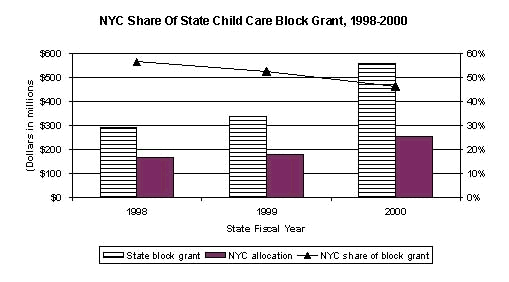New York City provides child care subsidies for approximately 96,000 children, at a cost of $586 million in 2000. There has been a significant increase in funding from the New York State Child Care Block Grant, which supports nearly half of the city's child care subsidies. However, these funds still will not cover all the needed slots the city has identified.
This article first reviews the types of care available and their cost for different age groups. The article continues with a discussion of the trends in the New York State Child Care Block Grant and concludes with a brief discussion of the anticipated block grant funding for 2001.
COST AND TYPES OF CHILD CARE SUBSIDIES
Children eligible for subsidized care fall into two groups. The first includes children whose parents participate in welfare work-related activities; they are primarily served by the Office of Employment Services (OES) at the Human Resources Administration. The second group includes children from working families who meet certain income eligibility criteria; they are served by the Agency for Child Development (ACD) at the Administration for Children's Services. For 2000, nearly 80 percent of the city's subsidies were funneled through ACD ($465 million), with the balance administered by OES ($121 million).
Subsidies are available for three types of child care. Informal care is provided in someone's home, and a provider is limited to serving two unrelated children. The subsidy cost-the amount paid by the city-ranges from $50 to $95 per week per child, depending on the age of the child. Group or family day care, which is also provided in a home but with a licensed provider who is allowed up to six children, costs between $65 and $127 weekly. Center-based day care is provided in a licensed facility and costs between $115 and $255 per week.
Subsidies are provided in three ways-payments to licensed providers, vouchers, or increases in public assistance recipients' cash grants. Recipients can use vouchers or grant increases for any type of care. The vast majority of ACD subsidies fund contracts with licensed providers. The majority of OES subsidies fund informal care through grant adjustments.
Since 1995, ACD has used $6,500, or $125 a week, as an average annual subsidy to estimate the number of slots that can be funded. However, the state Office of Children and Family Services recently updated its survey of market rates, which is the basis of the subsidy cost. Therefore, the annual average subsidy cost should be recalculated.
The table below shows how ACD's updated market rates are used to calculate the average subsidy cost based on the mix of services provided. More than four out of five children are in the more costly center-based care, which costs an average of $153 a week. For the whole ACD population, the weighted average cost per child care slot is $145 a week, or roughly $7,500 annually.

CHILD CARE BLOCK GRANT FUNDING
Child care subsidies are supported by a combination of federal, state, and city funding streams. Most of the federal and state money has been combined into the New York State Child Care Block Grant, which the state created in 1997 in response to the federal Personal Responsibility and Work Opportunity Reconciliation Act. The block grant is made up of federal Child Care Development Funds, transfers from the federal Temporary Assistance to Needy Families (TANF) block grant, and state funds.
For 2000, the block grant supports 44 percent ($257 million) of the city's child care subsidies. In order to receive block grant funds, local districts are required to maintain a designated level of local child care spending or maintenance of effort. The city's maintenance of effort requirement this year is $53 million.
The total state Child Care Block Grant has nearly doubled in recent years, rising from $294 million in 1998 to $558 million in 2000. For 2000, the block grant is made up of $232 million in federal Child Care Development Funds, $230 million in TANF transfers, and $96 million in state contributions.
Each year the state determines how much of the block grant is allocated to New York City. As shown in the chart, the city's block grant allocation increased 54 percent, from $167 million in 1998 to $257 million in 2000. While this is a significant increase, the city's share of the total block grant has declined over time. In 1998 the city received 57 percent of the statewide funds, but its share then declined to 53 percent in 1999 and to 46 percent in 2000.
The $558 million state block grant for 2000 has been released in two allocations. New York City received $241 million of the $457 million first allocation and $15 million of the $101 million second allocation. This brought the city's block grant funding to $257 million.
Using the re-estimated ACD subsidy cost of $7,500 per slot, the $79 million increase in funds from 1999 to 2000 would fund 10,530 additional slots, or approximately one fourth of the estimated 40,000 slots the city identifies as needed. The 40,000 figure includes 10,000 slots Human Resources Administration (HRA) recently testified may be needed by September 2000 due to additional welfare recipients who will be guaranteed child care when they participate in work-related activities. The balance of the slots is based on the 30,000 children who are on ACD's waiting list for care.

IBO's estimate of the cost of providing additional child care slots is based on the current mix of informal, family, and center-based care. The funds would support a greater share of the estimated need if more of them were used for less expensive informal care. Although greater use of informal care would yield more slots, this type of care is generally considered to be lower quality.
FUTURE FUNDING
For 2001, the state budget allocates $736 million for the Child Care Block Grant, an increase of $178 million, or 32 percent, over 2000. TANF surplus funds drive this growth, increasing by $165 million. In 2001, TANF funds will total $395 million or over half of the Child Care Block Grant. This growing reliance on the TANF surplus may be problematic, however. TANF expires in 2002, and it is uncertain whether the federal government will reauthorize the same level of funding. Moreover, the state's TANF surplus would shrink if welfare caseloads were to increase.
The city's allocation for 2001 has not yet been determined. If New York City were to receive the same 46 percent of the block grant as it did in 2000, it would receive $338 million, an $81 million increase for the year. However, given that the trend has been for the city to receive a declining share, this is far from certain.
For more information, contact Tammy Morales, Budget and Policy Analyst, at (212) 676-9247.